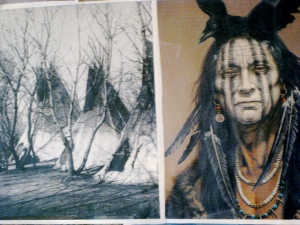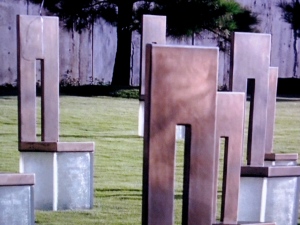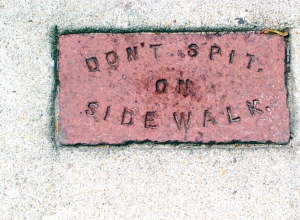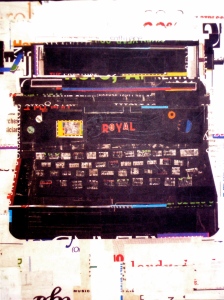
Osage wall hanging.

Native American art wall arrangement at Mt. St. Frances. (All photos taken by Marylin Warner)

Kirby Sattler’s posters are popular art in galleries and at Territory Days. The one on the right may look familiar if you recognize Johnny Depp’s costume in THE LONE RANGER.
In the state of Kansas, twelve counties are named for Indian tribes. Depending on which route I take each month when I drive to visit my mother—the interstate and main highways, or the blue highways—I drive through at least four of these counties.
Here are a few samples of my favorite Native American Indian quotes.
~ from Eagle Chief (Letakos-Lesa) Pawnee: “…All things in the world are two. In our minds we are two, good and evil. With our eyes we see two things, the fair and the ugly… We have the right hand that strikes and makes for evil, and we have the left hand full of kindness, near the heart. One foot may lead us to an evil way, the other foot may lead us to a good. So are all things two, all two.”
~ from Mourning Dove Salish (1888-1936): “…Everything on the earth has a purpose, every disease an herb to cure it, and every person a mission. This is the Indian theory of existence.”
“They are not dead who live in the hearts they leave behind.” ~Tuscarora
“We will be known forever by the tracks we leave.” ~Dakota
“No words are so eloquent as a rattlesnake’s tail.” ~Navajo
“You can’t wake a person who pretends to be asleep.” ~Navajo
“There is no death, only a change of worlds.” ~Pawnee and Shawnee
And this Cherokee quote was in a Kansas Original shop: “When the white man discovered this country, Indians were running it. No taxes, no debt, women did all the work. White man was wrong to think he could improve on a system like this.”
About the time my mother and I tried frying dandelion blossoms, (Fried Dandelions post) we also tried making FRY BREAD, a popular side dish at cafes and food stands serving Indian foods. Here’s the recipe we used:
In a medium bowl, mix together 2 cups flour, 1 T. baking powder, 1 t. seasoning salt or table salt, and 1 cup steaming tap water. Grease your hands with vegetable oil, shape the dough into a ball, and leave in the bowl. Cover with a towel and set in a warm place for at least 30 minutes. Setting the bowl in a sunny place works extra well.
Heat vegetable oil at least 1 inch deep in a fry pan or electric skillet (around 375 degrees). Make a ball of dough a little smaller than a golf ball and flatten in your greased hand until it’s about the size of a large cookie. Poke a small hole in the center with your finger and carefully lay the dough in the hot oil. Let dough fry to a gold brown before turning it over and frying the other side. Drain on paper towels and serve immediately.
Fry Bread has two uses. You can put meat, cheese, chopped tomatoes, onions and lettuce on Fry Bread for a main dish. Or you can do what Mom and I did: spread it with butter and sprinkle on cinnamon and sugar for a dessert.
September 25 is NATIVE AMERICAN DAY. That gives you plenty of time to make your Fry Bread, appreciate Indian art, look for interesting quotes, and maybe even read Hal Borland’s book, WHEN THE LEGENDS DIE, or Dee Brown’s BURY MY HEART AT WOUNDED KNEE. Both books will make you want to wear a t-shirt that says “INDIAN LIVES MATTER”


Kansas’ twelve counties named for Indian tribes.

























































